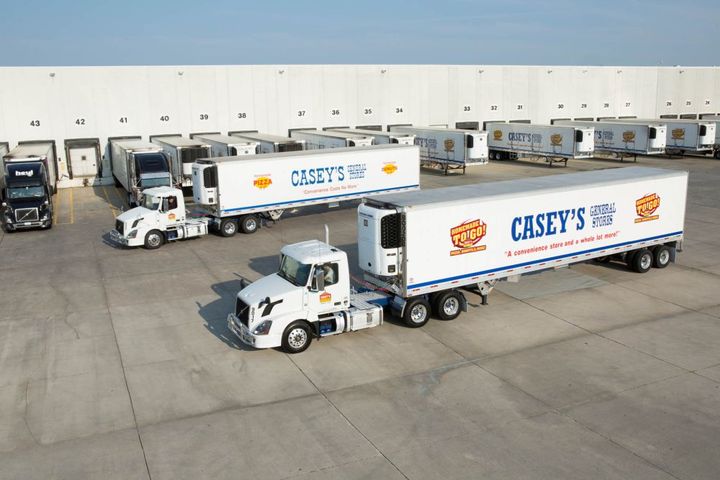Photo: Casey’s General Store
When spec’ing trucks, safety comes first and foremost. Fewer accidents mean lessdowntime, which means more customers can be served efficiently.
ared Hanis, director of Fleet & Maintenance for Casey’s General Stores, understands that part of being customer-focused involves taking care of those who serve said customers: the drivers who deliver the items they want.
Here, he discusses the steps the company has taken to ensure the vehicles they provide are safe and equipped to get the job done as efficiently as possible.
Casey’s Fleet Facts
Hanis stated Casey’s purpose is to make life better for its guests and communities every day. Founded in 1959, the company has grown to become one of the largest convenience store retailers and pizza chains in the U.S. It provides freshly prepared foods, quality gasoline, and friendly service to the communities where it operates and strives to deliver a work environment where team members are treated with respect, dignity, and honesty.
The Casey’s fleet is comprised of 850 vehicles total, with a 60% light-, 40% heavy-duty ratio. Their trucks are mainly used for service, support, and delivery functions.
Safety First Mentality
When spec’ing trucks, safety comes first and foremost. Fewer accidents mean less downtime, which means more customers can be served efficiently.
“Casey’s is constantly looking at adding additional features to our trucks to ensure the safety of all employees and the public,” he said.
A few of these added features include forward collision alert, automatic emergency braking, front pedestrian braking, following distance indicator, lane keep assist with lane departure warning, and auto high beam assist on light-duty units.
For the heavy-duty fleet, the company has recently added RollTek seats to its spec, which combine side airbag protection with the latest advances in seat belt technology. The product is custom-engineered based on the truck model it will be used in and helps to significantly reduce the potential for serious injury or death in a rollover.
Other technology the company has added to ensure safety include Lytx DriveCam, speed limiters, and Verizon Connect telematics.
Driving Forward with Data
Hanis has been working to enhance the company’s programs by creating additional visibility through business intelligence reporting. This enables him to create quick reports and custom dashboards for managers, adding immediate insight to operations and identifying risks.
Breaking into the Fleet World
When asked how he first got involved in fleet, Hanis replied, “Fleet found me.” He started in supply chain at Joy Global, now Komatsu in Arizona. He was eventually asked if he’d be interested in getting involved in fleet because the manager liked what Hanis did with the company’s inventory and in the tool room to reduce waste/overhead and streamlining processes.
“I agreed to help and started by dialing in our vendors, fixing our DOT score, and building a vehicle policy that drove accountability, thus reducing our overall cost by half a million dollars in the first six months. I then took these practices and implemented the practices throughout all of Joy Global Fleet, and the rest is history,” he shared
Never Stop Improving Service
Hanis advised other fleet managers to always get a competitive bid, even if it’s the same manufacturer. Don’t give in without trying to actively negotiate.Analyze and understand the data you collect before making changes to equipment.“The worst thing a company can do is put a unit in the field that is not functional for the job. Remember: just like your office, this is the drivers,” he said.
He also believes that to make the best decisions, you must get to know the business you work for on a deeper level.
“It’s imperative to get to know your customers and employees and their various job functions,” Hanis concluded.
CUT COTS OF THE FLEET WITH OUR AUDIT PROGRAM
The audit is a key tool to know the overall status and provide the analysis, the assessment, the advice, the suggestions and the actions to take in order to cut costs and increase the efficiency and efficacy of the fleet. We propose the following fleet management audit.




